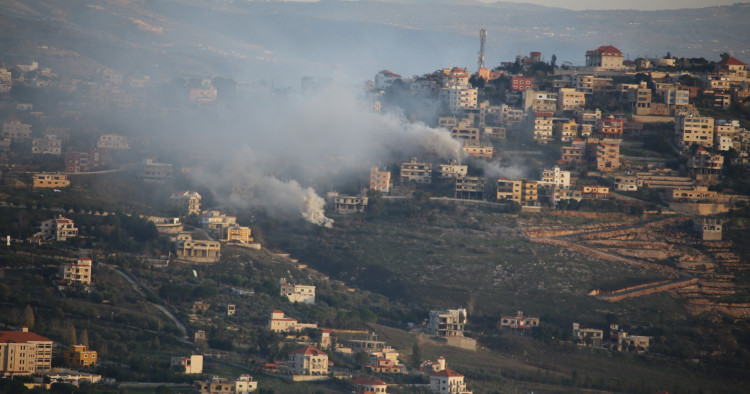Contents:
- The war is widening. Can anyone stop it?
- A major stress test for the Biden administration’s "diplomacy first" approach
- The war in Gaza is shifting into a new phase, but the Israeli government is not planning for the "day after"
- Despite talk of "downshift" and pending ICJ case, no letup in Israeli assault on Gaza
- Israel’s Supreme Court neutralizes threat of judicial overhaul, for now
- International community responds to growing Houthi threat in Red Sea
- Iran blames US and Israel for deadly ISIS attack on Iranian soil
The war is widening. Can anyone stop it?
Paul Salem
President and CEO

-
While the Biden administration hoped that the war in Gaza might begin to wind down by early 2024, major military operations are set to continue for many months, the Israel-Lebanon front is on the brink of a major eruption, attacks between Iranian proxies and the US are escalating, and the Houthis are disrupting global shipping in the Red Sea.
-
The Israeli right wing’s grand strategy to redraw its demographic and geopolitical realities, on the one hand, and Iran’s patient exploitation of a growing arc of conflict, on the other, threaten to lead the Middle East, and the world, in a very dangerous direction in 2024.
In November and December, the Biden administration urged Israel to wind down its major military operations in Gaza, hoping this might allow the war — and the region at large — to move away from escalation by early 2024. Instead, major military operations are set to continue for many months in Gaza, the Israel-Lebanon front is on the brink of a major eruption, attacks between Iranian proxies and the United States military are escalating in Iraq and Syria, and the Houthis are disrupting global shipping in the Red Sea. The war has already reached much of the Middle East; the risk is that the aperture and intensity of conflict will steadily rachet up in the coming weeks and months unless there is sharp progress to reverse course.
The Oct. 7 Hamas attack on Israel is sometimes compared to that country’s 9/11, but developments since then have more closely resembled the dynamics of 1948 and the Nakba. Much more than just a retaliation to destroy an attacker — in this case, Hamas — many on the Israeli far right are now advocating a much more radical approach to create new conditions for Israel: this includes the devastation of Gaza and preclusion of any major repopulation of this territory (by Palestinians), a ratcheting up violence in the West Bank to create conditions for a fundamental demographic change there, and also having the long-anticipated war with Hezbollah, to be able to eliminate this security threat “once and for all.”
The US — specifically, the Biden administration — opposes all three trajectories: a long war in Gaza, an escalation in the West Bank, and a large-scale Israel-Hezbollah war. It is also interesting to note that the leaders of the two countries, Prime Minister Benjamin Netanyahu and President Joe Biden, have opposing domestic political concerns: Netanyahu knows that the “day” after this prolonged war ends he will be out of office or, possibly, in jail; Biden knows that the longer this war drags on and spreads, the more it will weigh against him in the November elections. It is also clear that although Israel has, in fact, proven quite dependent on American military and financial support in this conflict, the leverage that the US is able, or willing, to wield on the Israeli government, is close to zero. Netanyahu has long ago gotten used to openly defying US presidents — especially Democratic ones — and is aware that the American political system will not enable any negative consequences for Israel. This means that Secretary of State Antony Blinken’s current tour of the region can only have very limited impact since he wields almost no influence over Israeli actions. The rest of the countries in the region want the US to push Israel to wind down its war in Gaza in order to pick up the pieces and move forward; but Blinken cannot deliver that.
Iran, meanwhile, has exercised its own strategy of steady and measured escalation. One of its allied militias, Hamas, dealt a staggering blow to Israeli security; 50 years ago, a similar blow required the combined armed forces of Egypt and Syria. In other words, Tehran’s model of asymmetric warfare has proven very effective. Iran is also pleased that the rush to normalization with Israel has been significantly paused and that Arab public opinion has swung sharply against it. Finally, the Iranian authorities are surely also pleased that Washington is increasingly isolated in the region for its support of this war. And as Iranian proxies and American forces fight it out, it is extremely significant that the US currently has no other regional allies — Arab or Turkish — in this current fight.
Interestingly, the only subregion that has been spared conflict is the Gulf itself, where the previous Saudi-Emirati-Iranian rapprochement has so far succeeded in maintaining calm and facilitating the continued flow of commerce. But as tensions mount in Gaza, the Levant, and the Red Sea, this Gulf calm cannot be assured. Any interruption in shipping there would directly impact energy markets and the broader global economy.
The Israeli right wing’s grand 1948-style strategy to redraw its demographic and geopolitical realities, on the one hand, and Iran’s patient exploitation of a growing arc of conflict, on the other, threaten to lead the Middle East, and the world, in a very dangerous direction in 2024. And with the United States having little leverage over Israel — or, for that matter, Iran — and no other regional or global player able to bend this dangerous trajectory, the region looks to be headed in a very explosive direction.
Follow on Twitter: @paul_salem
A major stress test for the Biden administration’s “diplomacy first” approach
Brian Katulis
Vice President of Policy

-
The Biden administration faces the possible limits of its “diplomacy first” approach in the Middle East as US Secretary of State Antony Blinken visits the region for the fourth time since the war’s outbreak.
-
The top priority of this current visit is preventing a wider regional escalation, something that can’t be achieved by diplomacy alone.
US Secretary of State Antony Blinken is on his fourth trip to the Middle East since Oct. 7 and the outbreak of the war in the Gaza Strip, at a time when the risk of a broader regional conflict has increased substantially. Shipping through the Red Sea continues to face threats from the Houthis, and daily skirmishes between Hezbollah in Lebanon and Israeli forces could spiral into a larger conflict at any moment.
Blinken is about halfway through a trip scheduled to take him to Turkey, Greece, Jordan, the United Arab Emirates, Saudi Arabia, Israel, the West Bank, and Egypt. His top priority is to look for pathways to de-escalate tensions on multiple fronts, and his diplomacy is coupled with stepped-up US military efforts aimed at restoring deterrence on several fronts. The Biden administration has also sent envoy Amos Hochstein in a diplomatic effort aimed specifically at trying to reduce tensions on the border between Israel and Lebanon.
On several stops along the way in recent days, Blinken highlighted “Operation Prosperity Guardian,” the multinational military effort the United States pulled together last month to defend the security and safety of shipping across the Red Sea. This effort involves more than 20 countries. But interestingly, some of America’s major partners in the Middle East that are affected by this instability were not formally announced as members of this effort.
In addition to trying to prevent a wider regional war, the Biden administration continues to try to secure the safe return of hostages held in Gaza, step up the flow of humanitarian aid to Gazan Palestinians, and work with partners to plan for the days after the war ends. Perhaps the trickiest and most delicate leg of the trip will come later, when Blinken arrives in Israel, as major gaps persist between the United States and Israel on what should happen to Palestinians today and in the future.
The current moment in the Middle East represents a major stress test for the Biden administration’s attempt to put “diplomacy first” in the Middle East, a slogan and template the Biden team offered when it entered office in 2021. Blinken and Hochstein’s diplomatic trips to the region represent the administration’s effort to live up to those promises. But in truth, diplomacy alone will not resolve the current crises until Israel no longer feels its war aims continue to necessitate military action and as long as Iran’s regional partners, including Hezbollah and the Houthis, maintain their strikes against Israeli and US regional interests.
Diplomacy backed by military tools and a credible threat of the use of force is historically more effective in producing stability and peace than diplomatic missions untethered from conflicts and tensions on the ground.
Follow on Twitter: @Katulis
The war in Gaza is shifting into a new phase, but the Israeli government is not planning for the “day after”
Nimrod Goren
Senior Fellow for Israeli Affairs

-
Three months after Oct. 7, Israel’s military operations in Gaza are entering a new phase, marked by a consolidated presence and more focused actions, even as concerns of further escalation with Hezbollah are on the rise.
-
While the United States and other international actors seek to advance diplomatic planning toward the “day after,” Benjamin Netanyahu’s government refuses to play along and is increasingly focused on political survival.
Though absent any major political announcement confirming this shift, Israel’s military operation in the Gaza Strip is entering a new phase. The Israel Defense Forces (IDF) are consolidating their presence in the northern part of the Gaza Strip, having achieved their military goals there. The IDF is now gradually focusing on more precise actions against specific Hamas targets — including trying to dismantle the Hamas stronghold in the key southern city of Khan Younis — in an effort to eliminate the militant group’s leaders as well as assist in the release of the remaining, 130 or so, Israeli hostages. Israel is not expanding its massive military campaign into the southern part of the Gaza Strip, taking into account Egyptian interests; and it is allowing more humanitarian aid into the Gaza Strip, than it wished to, given pressure coming from the United States and regional actors. In addition, security buffer zones are being created on the Gazan side of the Israel-Gaza border to prevent further infiltrations and to create conditions for the return of Israeli citizens who evacuated the area.
Israelis felt these changes in their daily lives over the last couple of weeks. The number of rockets fired into Israel by Hamas declined, and many Israeli reservists were released from duty. This gave Israelis some breathing space, although a limited and temporary one given deep widespread concern for the hostages still held by Hamas and the large number of IDF casualties. At the same time, focus is also shifting to the Israel-Lebanon border. Mounting tensions between Israel and Hezbollah are giving rise to mutual threats of further escalation. Israel emphasizes its readiness for increased military action but seems to prefer a diplomatic solution that will distance Hezbollah from its border, as advanced by US envoy Amos Hochstein.
This phase change in the Gaza war, could provide an opening for diplomacy and policy planning to move into high gear. New regional realities should be devised, and a transition process should be launched. Washington is apparently pushing for this to happen — as evident by US Secretary of State Antony Blinken’s visit to Israel and the region this week. But the Israeli government is working hard to avoid any such pro-peace diplomatic momentum. Benjamin Netanyahu’s government is reluctant to devise a vision for the “day after” the war, while its members voice conflicting (and often extreme) messages on the future of Gaza. Netanyahu is focused on his own political survival in view of low approval rates domestically, and the two-state solution — which the US, Europe, and regional countries want to advance following the war — comes nowhere near the Israeli prime minister’s agenda.
Israeli diplomacy is focused on other issues — confronting the South African case against it at the International Court of Justice, mobilizing international support for the release of hostages, and adapting to the recent rotation in the foreign minister’s position. A significant and constructive Israeli contribution to planning for the “day after” is therefore not likely prior to a power transition in Israeli politics. Consecutive polls indicate that Israelis yearn for new leadership. Until this happens, Israel’s military achievements on the ground are not likely to be translated into diplomatic gains toward peace.
Follow on Twitter: @GorenNimrod
Despite talk of “downshift” and pending ICJ case, no letup in Israeli assault on Gaza
Khaled Elgindy
Senior Fellow, Director of Program on Palestine and Palestinian-Israeli Affairs

-
American officials have repeatedly made clear that they want to see both a major reduction in civilian casualties and significant upscaling in the amount of humanitarian assistance reaching Gaza’s battered and besieged population, which continues to be subjected to constant bombardment, repeated displacement, and widespread hunger, though there’s been no meaningful change in either.
-
Given the Biden administration’s ongoing opposition to a cease-fire and the absence of any meaningful constraints on Israel’s prosecution of the war, a preliminary injunction by the International Court of Justice may be the only thing that forces Israel to change course.
For the past several weeks, the Biden administration has urged Israeli leaders to wrap up its large-scale “indiscriminate bombing” campaign, which has led to massive civilian casualties and widespread destruction, and transition to a more targeted military campaign in Gaza. So far, Israel’s military onslaught has killed at least 23,000 people in Gaza, roughly 1% of Gaza’s total population, the vast majority of whom were civilians, including some 9,000 children. Another 7,000 are missing and presumed dead under the rubble. Some 85% of Gaza’s population, around 1.9 million people, have been forcibly displaced, mainly in southern Gaza, while large segments of northern Gaza have been reduced to rubble. Moreover, Israel’s decision to cut off food, water, and fuel while severely limiting the amount of humanitarian assistance entering Gaza has led to widespread hunger and disease. More than a million people, around half of Gaza’s population, are now facing catastrophic conditions of “lack of food, starvation, and exhaustion of coping capacities.”
American officials have repeatedly made clear that they want to see a major upscaling in the amount of humanitarian assistance reaching Gaza’s battered and besieged population. While there is no indication that Israel is prepared to allow a significant increase in humanitarian assistance, Israeli and US officials now say that Israel is preparing to “downshift” its military campaign to a less intensive and more targeted phase of fighting. Last week, Israel began withdrawing thousands of troops from northern Gaza, where the Israeli military says it has assumed operational control, though there is no indication of when the broader anticipated downshift might take place. In the meantime, there has been no letup in the Israeli assault, particularly in southern Gaza, where Palestinian civilians are subjected to constant bombardment, repeated displacement, and widespread hunger. If anything, the weekend saw an intensification of Israeli bombardment by air, land and sea, with some 249 Palestinians killed over the past 24 hours, making it the deadliest single day since the war began.
All of this comes ahead of the anticipated hearing by the International Court of Justice (ICJ), which is scheduled to take place later this week (January 11-12) in The Hague, regarding a formal application brought by South Africa accusing Israel of committing genocide in Gaza. Unlike the International Criminal Court (ICC), to which Israel has refused to sign on, Israel is a signatory to the Genocide Convention. Although a final ruling by the ICJ could take years, the court could issue a preliminary ruling imposing “provisional measures,” such as ordering a cease-fire, opening crossings, obligating the entry of humanitarian aid, and stopping incitement to genocide, before the end of the month. Such a ruling would have far-reaching implications, including for the United States, which continues to provide enormous military, political, and diplomatic support for Israel’s war in Gaza. Indeed, given the Biden administration’s ongoing opposition to a cease-fire and the absence of any meaningful constraints on Israel’s prosecution of the war, a preliminary injunction by the ICJ may be the only thing that forces Israel to change course.
Follow on Twitter: @elgindy_
Israel’s Supreme Court neutralizes threat of judicial overhaul, for now
Eyal Lurie-Pardes
Visiting Fellow

-
The Israeli Supreme Court published rulings in two landmark cases last week, partially nullifying major components of the Netanyahu government’s plan to overhaul the judiciary.
-
Amid the war in Gaza and the shrinking public support for Benjamin Netanyahu, it is unlikely his unpopular government will be able to muster a majority necessary to relaunch a campaign to pass a judicial overhaul package.
Before the war in Gaza erupted, Israelis were engaged in a fierce debate over the Netanyahu government’s judicial overhaul plan aimed to weaken the judiciary. Hundreds of thousands of Israelis protested weekly against this initiative, though the controversy was temporarily shelved after the Oct. 7 terrorist attacks and the military mobilization against Hamas. But on Jan. 1 and 4, the Israeli Supreme Court published momentously important decisions on two petitions that challenged significant components of the judicial overhaul plan.
Last Monday, the court struck down the Reasonableness Amendment, which had stripped the Israeli judiciary of the right to practice judicial review of governmental acts based on the Reasonableness Clause, a central tenet of Israeli administrative law. For the first time in history, 12 out of 15 justices recognized the Supreme Court’s authority to strike down Basic Laws — the Israeli equivalent of constitutional amendments — if the Knesset (parliament) was found to have exceed its constitutional authority when it adopted them. In a narrower margin, eight justices ruled that the Knesset had, in fact, exceeded its authority when it passed the Reasonableness Amendment (to a basic law on the judiciary) last July.
Then, on Thursday, the Israeli Supreme Court postponed the implementation of the Recusal Law the Knesset passed in March 2023. The Recusal Law intended to limit the authority of the attorney general to recuse a sitting prime minister only to reasons of physical and mental incapacity; and the decision would have to be approved by a supermajority in the government or the Knesset’s House Committee. The government pushed through the Recusal Law rapidly, after several petitions were filed claiming the attorney general must recuse Prime Minister Benjamin Netanyahu because of the latter’s ongoing corruption trial and violation of provisions in his conflict-of-interest agreement that allows him to serve as head of government. In another split decision, 6 out of 11 justices ruled that the law had intended to benefit Netanyahu directly and thus did not meet the constitutional standard of general applicability. The court’s remedy was to postpone the effect of the new recusal mechanism until after the election and seating of the next Knesset.
If Israel were not simultaneously facing a series of historic crises stemming from the Oct. 7 terrorist attack, the ongoing war in Gaza, and border hostilities with Hezbollah, last week’s Supreme Court rulings would be an epochal political event. Netanyahu previously refused to commit to obeying a Supreme Court ruling that invalidated the Reasonableness Amendment. However, due to the shrinking public support for both Netanyahu and his government, he will find it challenging to reassemble a majority necessary to continue the efforts to overhaul the judiciary or to decline mandates from the court.
Furthermore, the consequential constitutional decision to recognize the Supreme Court’s ability to strike down basic laws had an overwhelming majority, which cut across the usual split between conservative and liberal justices. That said, the court’s other, more particular decisions reflected that ideological split, with the liberal justices prevailing based on the votes of former Chief Justice Esther Hayut and Justice Anat Baron, who retired last October. Therefore, how these precedents will affect future rulings remains to be seen.
International community responds to growing Houthi threat in Red Sea
Fatima Abo Alasrar
Non-Resident Scholar

-
The international response to the recent Houthi attacks in the Red Sea reflects a multifaceted approach involving military, diplomatic, and economic strategies that seek to balance immediate security needs with long-term regional stability.
-
The Houthis have warned the US that they will respond to the killing of their militiamen, but their capabilities in this regard are relatively limited.
The recent surge in Houthi attacks in the Red Sea has prompted a significant international response, with the United States taking a lead role in countering this threat, initiating Operation Prosperity Guardian. This multinational task force, under the Combined Maritime Forces, includes additional participation from several countries, including Bahrain, Canada, France, Italy, the Netherlands, Norway, the Seychelles, Spain, and the United Kingdom. The primary aim of this operation is to deter and respond to the Houthi assaults that have been disrupting one of the world’s most vital shipping lanes.
The ripple effects of the Houthi aggression are evident in the commercial shipping sector. Because of the increased risks to crews and vessels, insurance premiums for navigating the Red Sea have surged. Therefore, major shipping companies have adjusted their routes, often opting for longer, more costly paths around Africa’s Cape of Good Hope. These higher operational costs are likely to affect global trade patterns and consumer prices, highlighting the far-reaching implications of the Houthi attacks.
Diplomatically, the US, UK, Bahrain, and other countries issued stern warnings to the Houthis, demanding an immediate cessation of attacks and cautioning against the destabilizing impact of their actions. They also emphasized the illegality of these attacks and the potential consequences should they continue. Meanwhile, the United Nations Security Council (UNSC) has also been closely monitoring the situation. Discussions within the UNSC have focused on the risks of further escalation and the potential threat to ongoing peace talks between Saudi Arabia and the Houthis. The UNSC has called for enhanced international and regional cooperation to address these threats.
The Houthis are unlikely to stop their attacks without military pressure, however. Their officials have declared that the US will “not escape punishment and retaliation,” after sinking three Houthi boats and killing 10 militants in the Red Sea. This tone is part of the group’s broader strategy to assert power and gain leverage in the regional context, particularly considering its ties with Iran. While the threat must be taken seriously, the Houthis actually have fairly limited capabilities to execute any significant retaliatory actions against the US.
The Houthis claim they are targeting ships linked to Israel as a form of pressure, but their activities in the Red Sea indicate a growing alignment with Iranian regional strategies, with significant implications for the political and security situation in Yemen. Their aggressive stance and military activities undermine the potential for establishing a legitimate and democratic governance system within the country. Houthi governance, which lacks broad legitimacy, often imposes itself by force, further complicating the political landscape in Yemen. The Houthis’ actions and their unilateral control in certain regions of Yemen thus hamper efforts toward establishing a representative and inclusive political system. The earlier the international community begins to understand this and moves to demilitarize the Houthis, the more feasible it will be to achieve a sustainable and peaceful resolution of the Yemeni civil war.
Follow on Twitter: @YemeniFatima
Iran blames US and Israel for deadly ISIS attack on Iranian soil
Alex Vatanka
Director of Iran Program and Senior Fellow, Black Sea Program

-
Rather than openly admitting to the growing strategic threat that ISIS poses to the Iranian homeland, Tehran is chasing a petty propaganda feud against Israel and the United States.
-
This blame diversion only hurts Iranian security since the threat of ISIS is badly minimized while Tehran invests energy in its self-proclaimed holy struggle on the international stage.
The Jan. 3 terrorist attack in Kerman, Iran, which left about 90 people dead, was the worst mass killing the Islamic Republic experienced since its founding in 1979. ISIS claimed responsibility, but officials in Tehran have been downplaying this simple reality and instead attempt to implicate Israel and the United States.
Rather than openly admitting to the growing strategic threat that ISIS — as a vehemently anti-Shi’a and anti-Iran entity — poses to the Iranian homeland, Tehran is chasing a petty propaganda feud. This is not about policy confusion in Tehran. Iran’s leadership, by choice, continues to prioritize confronting the US and Israel at the expense of safeguarding basic Iranian interests, such as keeping ISIS out.
A few factors are worth underscoring. It is natural to speculate about a link between the Kerman attack and the war in Gaza: Some observers have suggested the terrorist strike was the result of Iranian-Israeli rivalry and the two countries’ cycle of tit-for-tat attacks against each other. Israel has good reason to want to attack Iran and embarrass the Iranian regime. But Israeli attacks inside Iran in the past two decades have never been indiscriminate like this. Did the Oct. 7 Hamas attack change Israel’s modus operandi against Tehran? All that is clear is that Tehran’s evidence of a US or Israeli role in the Kerman attack is limited to citing reports by a US journalist from the 2000s who reported that the US and Israel maintained open channels with militant Iranian groups.
Against this theorizing is the long list of verifiable attacks by ISIS and similar groups inside of Iran in recent years. Prior to last week’s Kerman bombings, the most recent incident occurred in December, when an ethnic-Sunni Baluch group, Army of Justice (Jaish al-Adl), took responsibility for an attack that killed 11 Iranian security forces. ISIS, in turn, has claimed at least five attacks in Iran since 2017 and, after Kerman, has vowed to carry out more violence. This is hardly surprising. ISIS and Iran view each other as mortal enemies. After all, the Kerman attack happened on the fourth anniversary of the US assassination of Qassem Soleimani, a man who took credit for the fall of the Islamic State caliphate in Iraq and Syria.
The record of bad blood between Iran and ISIS speaks for itself. In fact, since the Islamic State-Khorasan Province (ISIS-K, the group’s branch in Afghanistan) was created in 2015, Iranian officials themselves have repeatedly warned about the growing threat the group poses to Iran. And yet, after the Kerman attack, leaders in Tehran have so far opted to deflect and blame its nemeses, US and Israel. This blame diversion only hurts Iranian security since the threat of ISIS is badly minimized while Tehran invests energy in its self-proclaimed holy struggle on the international stage.
Follow on Twitter: @AlexVatanka
Photo by Ramiz Dallah/Anadolu via Getty Images
The Middle East Institute (MEI) is an independent, non-partisan, non-for-profit, educational organization. It does not engage in advocacy and its scholars’ opinions are their own. MEI welcomes financial donations, but retains sole editorial control over its work and its publications reflect only the authors’ views. For a listing of MEI donors, please click here.












